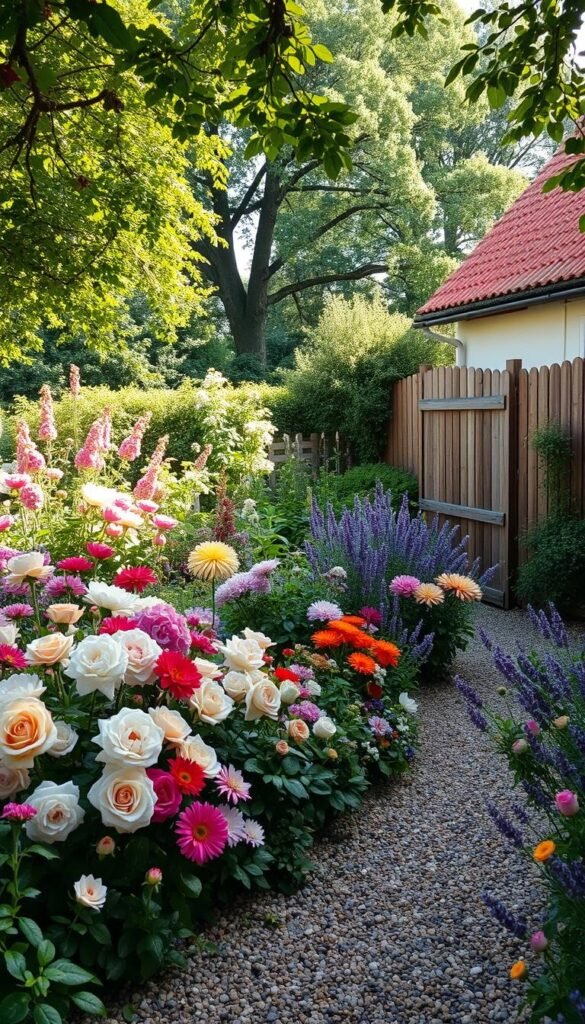Imagine stepping into a living painting where vibrant hues dance alongside fragrant blossoms. This is the magic of traditional cottage horticulture, a design approach rooted in 16th-century practicality that’s now cherished for its romantic appeal. What began as humble plots for growing food and medicine evolved into artful spaces blending functionality with natural beauty.
Modern enthusiasts adore this aesthetic for its ability to transform backyards into whimsical retreats. The secret lies in balancing structured elements like winding walkways with free-growing plant clusters. You’ll find edible herbs mingling with ornamental species, creating visual interest while serving multiple purposes.
Why does this centuries-old tradition remain popular? It offers an escape from rigid landscapes, inviting spontaneous creativity while maintaining intentional design foundations. From weathered stone paths to clusters of lavender swaying near sun-bleached benches, every detail contributes to that coveted lived-in charm. For those drawn to cottagecore aesthetic trends, these spaces provide endless inspiration.
Creating your own version requires understanding its core principles. Think abundant plantings that bloom in succession, vintage accents like repurposed ironwork, and textures that soften edges over time. The result? A sanctuary that feels both curated and wild—proof that careful planning can achieve effortless elegance.
Discovering the English Cottage Garden Aesthetic
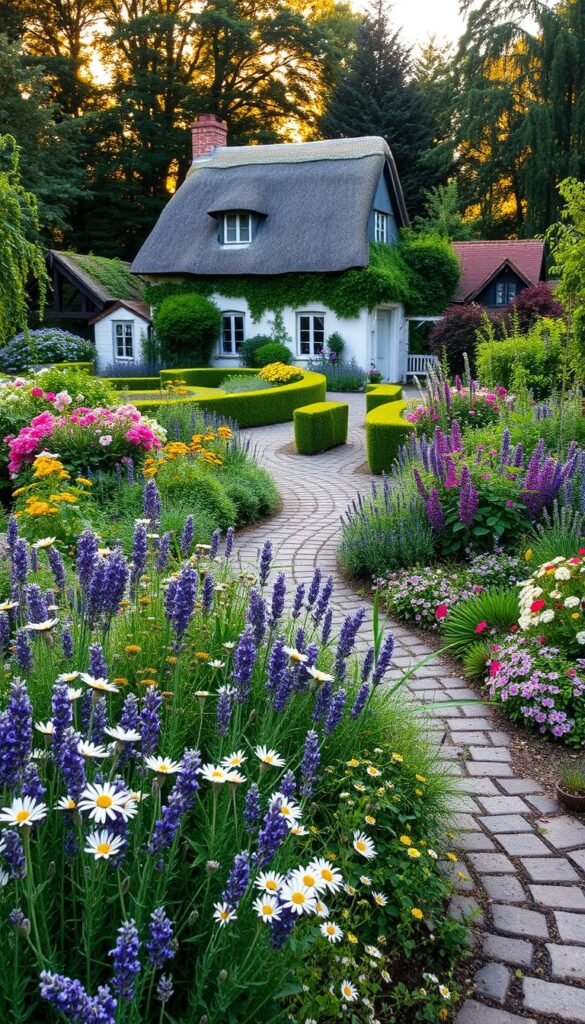
Picture a space where history and horticulture collide—where weathered stone paths guide you through bursts of color that seem to have grown there for centuries. This is the essence of the cottage garden aesthetic, a design philosophy that whispers stories of medieval herb plots transformed into living art.
From Practical Roots to Poetic Expression
Originally serving as multifunctional spaces for food and medicine, these gardens gained romantic flair in the 19th century. Visionaries like Gertrude Jekyll reimagined them as plant-filled sanctuaries, blending loose floral arrangements with strategic structure. Their enduring appeal? “A garden should look like it’s been loved, not arranged”—a philosophy that still resonates today.
Signature Elements That Define the Look
Three key features create that coveted cottage charm:
- Layered plantings: Tall spires of delphiniums behind billowing peonies, with creeping thyme softening edges
- Architectural anchors: Rustic arbors draped in honeysuckle or symmetrical raised beds framing wilder growth
- Textured pathways: Crushed gravel or reclaimed brick walkways that invite exploration
The magic lies in balancing planned elements with nature’s spontaneity. Foxgloves might self-seed near your lavender patch, while climbing roses tumble over a repurposed iron gate—proof that careful design can feel deliciously uncontrived.
Essential Design Elements for Your English Garden
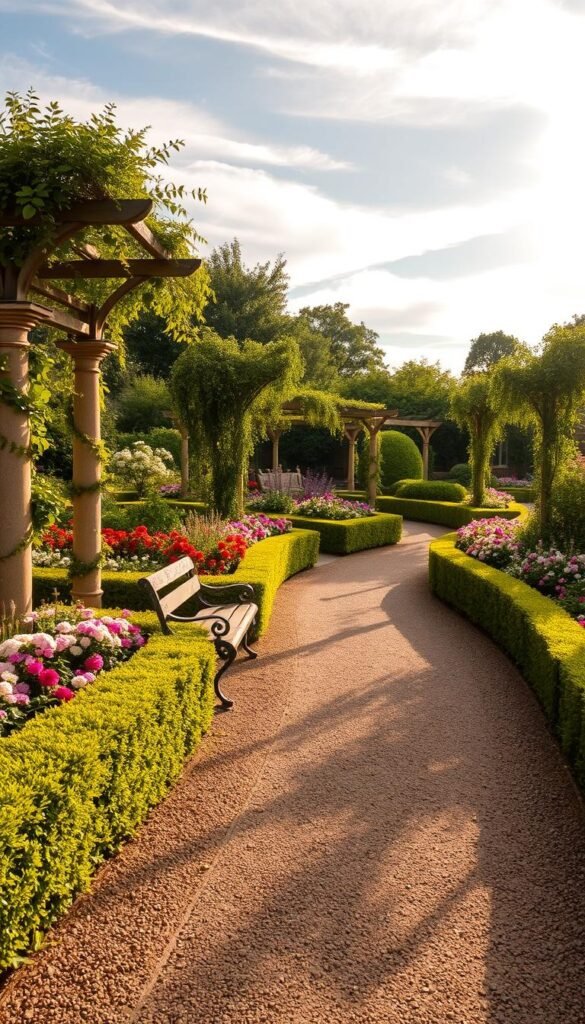
Transform your outdoor space into a storybook scene through thoughtful layout strategies. The magic lies in balancing structured elements with nature’s spontaneity—a principle central to traditional garden design.
Crafting Curious Walkways and Framed Edges
Meandering trails do more than connect points—they spark curiosity. Use materials like gravel or reclaimed brick to mimic timeworn charm. Let paths curve around existing trees or slope gently toward hidden features like a weathered bench.
Border your walkways with low-growing herbs or creeping thyme. These living frames release fragrance when brushed against, turning every stroll into a sensory experience. For inspiration on blending practicality with beauty, explore gardening aesthetic inspiration.
Mastering Plant Partnerships
Combine self-sowing annuals like cosmos with reliable perennials such as foxgloves. This mix ensures constant color while maintaining that “wild but intentional” look. Plant in generous clusters—groups of five or seven create visual impact without appearing rigid.
Allow flowers to spill onto walkways slightly. Delicate blooms brushing against stone or gravel soften edges naturally. Remember: the goal isn’t perfection, but rather layers that evolve gracefully each season.
How to Create Your Own English Flower Garden Style: Timeless Classic Blooms and Quaint Pathways
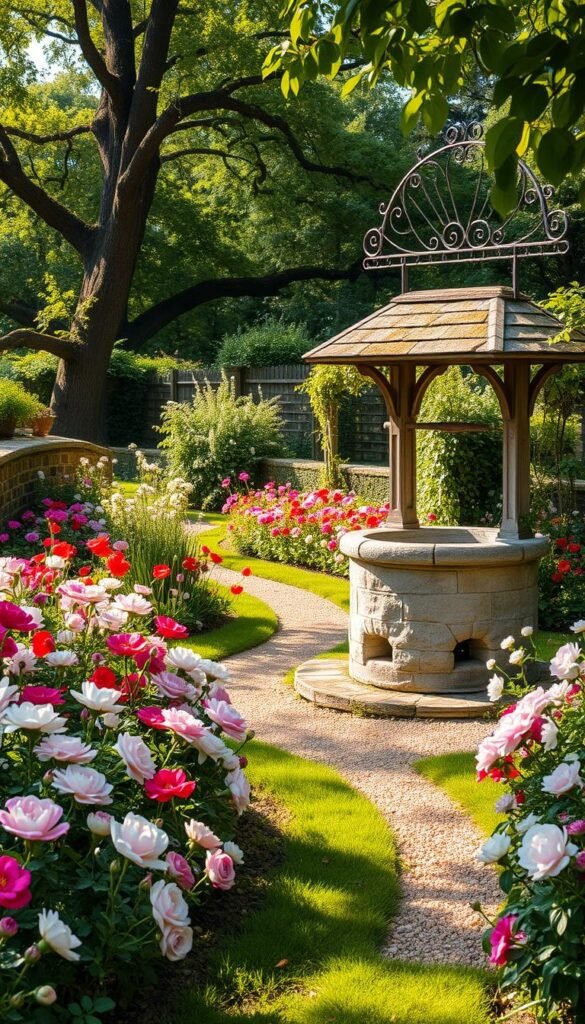
Turn your backyard into a living tapestry that evolves with the seasons. Start by establishing a framework using trees and clipped shrubs—these create height and privacy while softening modern structures. Think holly or hawthorn for year-round structure, then layer in character with climbing roses on arbors or fences.
Step-by-Step Planting and Layout Guide
Begin with woody plants that form your garden’s “bones.” Once established, add roses—shrub varieties like David Austin’s English types work beautifully as borders. Train climbers like ‘New Dawn’ over arches for vertical drama. Fill gaps with perennials that bloom in waves: foxgloves in spring, lavender in summer, ornamental grasses for autumn texture.
Disguise contemporary features by planting fast-growing screens. Use elderberry bushes or clematis-covered trellises to hide AC units or vinyl siding. Remember: even urban spaces can feel rural when greenery softens hard edges.
Tips for Maintenance and Seasonal Flourish
Prune roses in early spring but leave some hips for winter interest. Let self-seeding plants like poppies wander freely—their spontaneous growth adds authenticity. For year-round bouquets, include plants with interesting seed heads (alliums) and winter stems (red-twig dogwood).
Water deeply but infrequently to encourage strong roots. Mulch with compost each fall to nourish soil naturally. As your space matures, it’ll develop that coveted “always been here” charm—proof that patience creates perfection in cottage garden design.
Modern Inspirations and Traditional Touches for an Enchanting Space
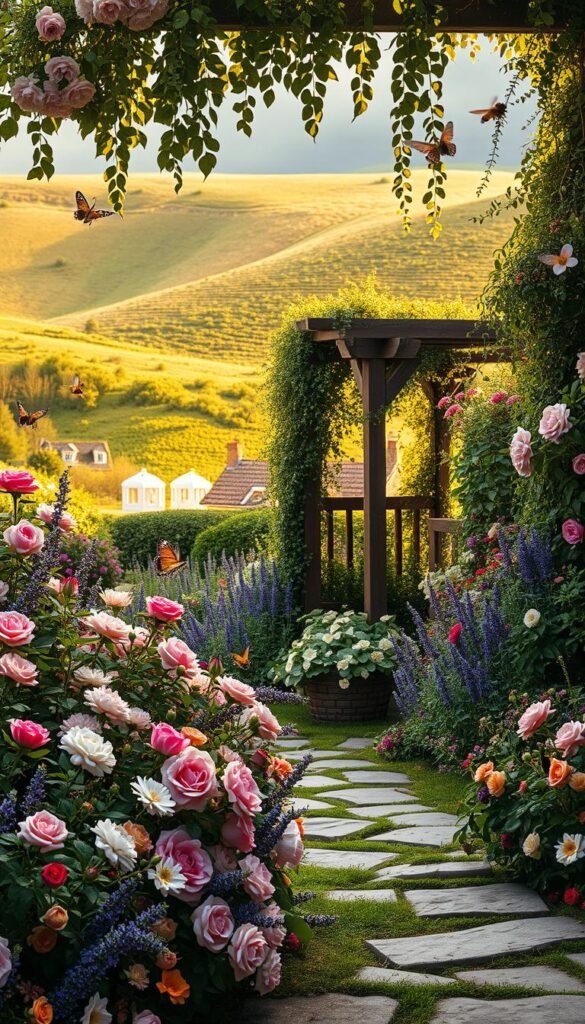
Breathe new life into your outdoor sanctuary by merging contemporary ideas with classic charm. Today’s designs honor heritage while embracing eco-conscious practices, creating spaces that feel both nostalgic and fresh.
Incorporating Climbing Roses, Lavender, and Herbs
Train climbing roses over arched entryways to frame views with their perfume-rich blooms. Pair them with silvery lavender hedges that buzz with pollinators by day and release calming scents at dusk. Tuck culinary herbs like thyme between stepping stones—their edible flowers add pops of color while keeping flavors within reach.
Blending Self-Seeded Naturalism with Planned Design
Let poppies and forget-me-nots wander freely through borders, then anchor their spontaneity with structured shrub roses. This balance creates rhythm—wildflowers soften formal edges while repeat-blooming perennials maintain visual continuity. Use stone markers or low fences to gently guide growth without stifling nature’s artistry.
Encouraging Biodiversity for a Lush Retreat
Install insect hotels near herbaceous borders buzzing with nectar-rich plants. Cluster native species like milkweed and coneflowers to support butterflies, then add a birdbath surrounded by berry-bearing shrubs. These habitats transform your space into a thriving ecosystem where every creature contributes to the garden’s vitality.
By weaving modern ecological awareness into time-tested designs, you create more than just beauty—you cultivate a living sanctuary that nourishes both earth and spirit.
Bringing It All Together: Crafting Your Dream English Garden Vision
Your journey to a captivating outdoor retreat begins with blending heritage techniques with personal creativity. Whether shaping a compact urban plot or sprawling estate, the magic lies in balancing structured elements with nature’s free-spirited growth. Let gravel paths guide discovery while allowing poppies to self-seed freely—these contrasts create that cherished “always been here” atmosphere.
Skilled designers achieve this charm through subtle interventions. Tuck edible herbs between ornamental blooms, or use clipped shrubs to frame wilder planting zones. For modern adaptations, consider potager-inspired layouts where vegetables mingle with cutting varieties—beauty and function intertwined.
Focus on layered textures that evolve seasonally. Spring’s foxgloves give way to summer’s lavender spires, while autumn’s ornamental grasses add movement. Even small spaces gain depth when vertical climbers like clematis soften walls or fences.
Remember: true success comes from letting your space tell its own story. Allow perennials to sprawl slightly beyond borders, and let moss creep between stepping stones. With thoughtful planting and patience, you’ll craft a living sanctuary that feels both curated and wonderfully wild.

